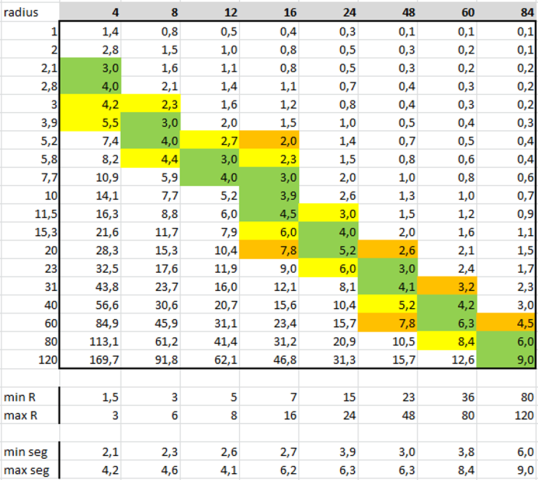| Welcome, Guest |
You have to register before you can post on our site.
|
| Forum Statistics |
» Members: 5,530
» Latest member: YANG
» Forum threads: 6,305
» Forum posts: 52,540
Full Statistics
|
| Online Users |
There are currently 200 online users.
» 1 Member(s) | 194 Guest(s)
Applebot, Bing, Facebook, Google, Yandex
|
|
|
| Vertex precision |
|
Posted by: Peter Blomberg - 2025-10-09, 15:14 - Forum: Official File Specifications/Standards
- Replies (4)
|
 |
For free-form stand-alone vertexes, one decimal is usually enough. However, when a vertex is defined by a circular primitive, rotated subparts or the intersection of slanted surfaces, then more decimals are needed. I've tried working with three decimals, but tools like Edger2 will not always recognize the presence of a cond line rounded to three decimals. Similar results with overlap- and gap-finding tools.
The official parts library specifications state "In general, three decimal places are sufficient for parts, subparts, and primitives representing portions of parts that are not intended to be scaled (for example, studs, pegs, peg-holes, clips, hinge ends, etc.). Four decimal places should be used for high-res primitives and any primitives designed to be scaled (for example, cylinder sections, boxes, rectangles, discs, edges, etc.) as this allows such primitives to be scaled by a factor of ten while still preserving three decimal places of accuracy.".
I'd like to amend this by allowing 4 decimal places to be used for - vertexes on a rotational plane of symmetry (e.g. 30, 45, and 72 degree planes),
- intersections calculated by isecalc,
- any vertex that is defined by a scaled primitive.
The first one because this will avoid gaps/overlap when multiple similar subfiles are put together in a larger assembly.
The second one to have an accurate edge line where two surfaces intersect each other.
The third one to avoid gaps/overlap next to any scaled primitive. This is also needed for all cond lines that have a point or a control point on such a vertex.
If we all agree, can this be made official?
|

|
|
| Cylindrical polygons |
|
Posted by: Peter Blomberg - 2025-10-08, 6:33 - Forum: Official File Specifications/Standards
- No Replies
|
 |
Currently, we have cylindrical polygons with 8, 16, and 48 sides. So, if a part needs a 1-6 sweep, we are forced to use the 48-sided polygon. For very large radii, even 48 sides is not enough. We have 84-sided polygons on the tracker. When we need a cylinder with the number of faces divisible by 5, a custom 50-sided polygon becomes used. What if 16 points are too coarse and 48 points are too dense?
I'd like to solve these by introducing 12, 24, 60, and 84-sided cylinders. The 12-sided is a nice replacement for the 8-sided because three segments make much nicer corners than 2 segments. The 24-sided is perfect when 48 is too much and 16 too little. Both allow 1-6 sweeps. The 60-sided cylinder is more usable than the 50-sided cylinder in that it is divisible by both 3 and 4. The point of the 84-sided cylinder is that the vertexes are distributed differently (divisible by 4, but not by 8) than any multiple of 48, thus allowing vertex optimization at large radii.
The 60-sided cylinder would be used at radii above 36.
The 84-sided cylinder would be used at radii from 80 to 120.
Here's a table showing the segment length for different radii and polygons. Below are recommendations for minima and maxima (radii and segment length) for each polygon optimized for segment length.

The polygon "4" is just a corner made out of one quad at a 45 degree angle.
|

|
|
| List of Moved To's that point to Moved To's |
|
Posted by: Orion Pobursky - 2025-10-08, 0:33 - Forum: Parts Tracker Discussion
- No Replies
|
 |
Moved To's shouldn't point to Moved To's. Here's a list of the current parts that do that:
(Note: I didn't vet every part here. There may be false positives or some reason not to untangle the redirects but the default should be that Moved To's should point correctly)
parts/100.dat, http://library.ldraw.org/parts/180
parts/134.dat, http://library.ldraw.org/parts/558
parts/138.dat, http://library.ldraw.org/parts/623
parts/148.dat, http://library.ldraw.org/parts/741
parts/149.dat, http://library.ldraw.org/parts/742
parts/179.dat, http://library.ldraw.org/parts/1166
parts/193.dat, http://library.ldraw.org/parts/1468
parts/197.dat, http://library.ldraw.org/parts/1576
parts/240.dat, http://library.ldraw.org/parts/2192
parts/2455.dat, http://library.ldraw.org/parts/2476
parts/249.dat, http://library.ldraw.org/parts/2540
parts/252.dat, http://library.ldraw.org/parts/2605
parts/256.dat, http://library.ldraw.org/parts/2721
parts/275.dat, http://library.ldraw.org/parts/3075
parts/2909c01.dat, http://library.ldraw.org/parts/3305
parts/291.dat, http://library.ldraw.org/parts/3306
parts/3010p20w.dat, http://library.ldraw.org/parts/3921
parts/3068p101.dat, http://library.ldraw.org/parts/4997
parts/3068p50.dat, http://library.ldraw.org/parts/5002
parts/3149c.dat, http://library.ldraw.org/parts/5432
parts/321.dat, http://library.ldraw.org/parts/5570
parts/32133c01.dat, http://library.ldraw.org/parts/5585
parts/3324a.dat, http://library.ldraw.org/parts/5968
parts/34.dat, http://library.ldraw.org/parts/6043
parts/3626-4t.dat, http://library.ldraw.org/parts/6331
parts/3660p03.dat, http://library.ldraw.org/parts/6690
parts/4.dat, http://library.ldraw.org/parts/7485
parts/405.dat, http://library.ldraw.org/parts/7553
parts/407.dat, http://library.ldraw.org/parts/7628
parts/408.dat, http://library.ldraw.org/parts/7637
parts/415.dat, http://library.ldraw.org/parts/7846
parts/4265c.dat, http://library.ldraw.org/parts/8450
parts/432.dat, http://library.ldraw.org/parts/8539
parts/48.dat, http://library.ldraw.org/parts/9622
parts/480.dat, http://library.ldraw.org/parts/9623
parts/4865p02.dat, http://library.ldraw.org/parts/9745
parts/5.dat, http://library.ldraw.org/parts/9829
parts/553.dat, http://library.ldraw.org/parts/10176
parts/56.dat, http://library.ldraw.org/parts/10225
parts/577.dat, http://library.ldraw.org/parts/10317
parts/590.dat, http://library.ldraw.org/parts/10416
parts/6.dat, http://library.ldraw.org/parts/10479
parts/605.dat, http://library.ldraw.org/parts/10655
parts/680c01.dat, http://library.ldraw.org/parts/11998
parts/7.dat, http://library.ldraw.org/parts/12048
parts/73696.dat, http://library.ldraw.org/parts/12344
parts/73696c00.dat, http://library.ldraw.org/parts/12345
parts/73697.dat, http://library.ldraw.org/parts/12350
parts/73697c00.dat, http://library.ldraw.org/parts/12351
parts/810.dat, http://library.ldraw.org/parts/12728
parts/91.dat, http://library.ldraw.org/parts/13418
parts/95.dat, http://library.ldraw.org/parts/14049
parts/99.dat, http://library.ldraw.org/parts/15065
|

|
|
| File naming convention for part 87079? |
|
Posted by: Peter Grass - 2025-10-07, 5:17 - Forum: Parts Authoring
- Replies (2)
|
 |
The naming convention for part 87079 seems to start off being hexadecimal and then kinda goes random but there are gaps like there is no 87079PC or PD, PE, PJ to L etc. So what number am I supposed to use? Should I just fill one of the gaps?
|

|
|
| Duplo hitches |
|
Posted by: Peter Blomberg - 2025-10-06, 10:05 - Forum: Parts Authoring
- Replies (8)
|
 |
Now that more duplo trains and cars are modeled, we should think about the primitives for the hitches aka tow pins, tow loops, and tow clips. Duplo hitches come in many types and variants. However, when minor differences are ignored, it boils down to a handful tow pins and tow hooks.
Long unreinforced tow pin
Suggested archetype: 4883a in LDraw
The classical tow pin has a long neck and no topside reinforcement.
4559, 4580 (Corrected), 4883a, 4883b, 53053, 31300 (Corrected), 59273a (Rebrickable)
Long fully-reinforced tow pin
Suggested archetype: 22307 in Rebrickable
The classical tow pin with long neck and full topside vertical reinforcement.
31507 (Corrected), 22307 (Rebrickable), 59273b (https://www.ebay.com/itm/365018516343)
Short unreinforced tow pin
Suggested archetype: 2312 in LDraw
This tow pin has short neck, no topside reinforcement.
2312, 31300a, 4580b, 6505
Clasped tow pin
Suggested archetype: 52071 in Rebrickable
This tow pin has short neck and horizontal triangle covering the topside
1326, 2034, 18520, 52071, 54007
Short fully-reinforced tow pin
Suggested archetype: 11248 in LDraw
This tow pin has short neck and full topside vertical reinforcement.
11248, 31300b, 15313, 15314, 31174, 95462, 98214, 58234, 53899, 4354
Short half-reinforced tow pin
Suggested archetype: 28759
This tow pin features a curved topside reinforcement.
28759, 28743, 2092
Tow loop
Suggested archetype: 4883a in LDraw
Features a closed tow loop/hook
4883a
Rectangular tow clip
Suggested archetype: 53053
Features an open tow clip/hook on a triangular rectangular support.
2320, 6505, 53053
Rounded tow clip
Suggested archetype: 2312&11248 in LDraw
Features an open conically-tapered tow clip/hook on a rounded support.
2312, 11248, 31174, 52071
Untapered tow clip
47450
Trailer tow clip with wheel, horizontal
18520, (87657), (87658), (89198)
Trailer tow clip with wheel, angled
14923
This list is not exhaustive. Some additional cases were omitted.
4883b reinforced clip/hook (https://www.ebay.com/itm/186383419871)
4820 reinforced trailer clip/hook
All movable clips/hooks
|

|
|
| Numbering and naming for sail triangular 6x12 modern type |
|
Posted by: Takeshi Takahashi - 2025-10-05, 12:29 - Forum: Parts Authoring
- Replies (3)
|
 |
Hello,
I'm going to create part 16292 (Plastic Triangle 6 x 12 Sail with 'HLC-37' Pattern) for Friends/DP/Elves OMR project and I have some questions.
https://www.bricklink.com/v2/catalog/cat...2#T=C&C=12
The part shape is similar but obviously different to currently existing plastic sail u66 (the shoulder near the top and the hole for horizontal beam).
1. There are several print variants sharing the same cutting die, but we have no unprinted version.
https://www.bricklink.com/v2/search.page...x%2012#T=A
So I suggest as follows (u9179 is the u-number assigned to me):
u9179 Sail 6 x 12 Triangular Modern : unprinted version
u9179p01 Sail 6 x 12 Triangular Modern with Orange and Red Pattern : Part 93383 (Year 2011)
u9179p02 Sail 6 x 12 Triangular Modern with with "HLC-37" Pattern on Back Side : Part 16292 (Year 2014, the only variant printed on opposite side)
u9179p03 Sail 6 x 12 Triangular Modern with Dark Blue Wave in Circle and Dark Azure, Dark Blue and Green Markings Pattern : Part 32917 (Year 2017)
u9179p04 Sail 6 x 12 Triangular Modern with Lime and Bright Light Blue Wave and Yellow Sun Pattern : Part 1601 (Year 2022)
93383 : Alias to u9179p01
16292 : Alias to u9179p02
32917 : Alias to u9179p03
1601 : Alias to u9179p04
If there are better way, it will be highly appreciated.
2. Is the naming "Triangular Modern" appropriate? Should be more specific?
|

|
|
| Duplo parts not yet in LDraw |
|
Posted by: Peter Blomberg - 2025-10-03, 1:20 - Forum: Part Requests
- Replies (16)
|
 |
Having a special interest in Duplo, I made an inventory of relatively common parts for sale that are not yet on the LDraw part tracker. Naturally, I made a biased selection avoiding animals, figures, patterned parts, and special themes. Some of the parts in the list below are old and cannot be found in BI, some are newer, but still not in BI. Some are available as raw meshes in BI. Some can be created based on pictures. Some can be created by measuring the physical part, but some are so complex manual measurements would take a long time. Some could be scanned using a 3D scanner.
Which are available from the LEGO Builder instructions app (BI)?
10563 Duplo Container Box 2x4x2 Door with Handle
11841 Duplo Car Base 2x6 with Tyres and Wheels on Fixed Axles
12591 Duplo Car Base 2x4 with Fixed Axles, Tyres, and Wheels
13247 Duplo French Bread Loaves with Short Side Extensions
1326 Duplo Truck Semi-Tractor Chassis
13535 Duplo Boat with 8 Studs (is in BI, but the mesh is inadequate)
15313 Duplo Car Base 2x6 Tractor with Mudguards and Wheels with Tyres
15454 Duplo Car Body Truck 4 x 4 Flatbed with 4 Top Studs
15575 Duplo Boat Hull Unitary 7 x 12, Top
15576 Duplo Boat Hull Unitary 7 x 12, Base
15577 Duplo Ice Cream Waffle Cone
16196 Duplo Airplane Small
16205 Duplo Animal Accessory Cratch
16265 Duplo Utensil Wrench with Smooth Handles
16598 Duplo Door / Window Pane 1 x 4 x 3 Curved Front with Rounded Pane
18720 Duplo Airplane Midsize Fuselage Base with Wings
18721 Duplo Airplane Midsize Fuselage Top
18806 Duplo Container Box 2 x 4 x 2 with Open Sides
19443 Duplo Ladder 7 Rung with Locking Ring and Drum Narrow Ridged Holder
2156 Duplo, Plate 8 x 3 Cut Corners On tracker
21997 Duplo Digger Bucket, Small with Locking Ring - 4 teeth
21998 Duplo Front End Loader Bucket with Locking Ring - 7 Teeth
2292 Duplo Wheelbarrow with Thin Black Wheels
2992 Duplo Wheelbarrow with Thick Black Wheels
23230 Duplo Carrots
23233 Duplo Maize / Corn
23742 Duplo Rock Round with Hole in Center
2390 Duplo, Plant Leaf / Strawberry Top On tracker
23925 Duplo, Brick 2 x 2 x 2 Bag
23927 Duplo Bridge Log with Holes
23990 Duplo Utensil Watering Can
24181 Duplo Utensil Surfboard
24955 Duplo Utensil Jackhammer
25551 Duplo Bulldozer Blade
25600 Duplo Caterpillar Base with Black Treads
25632 Duplo Horse Wings with Feathers
26249 Duplo Door / Window Pane 1 x 4 x 3 with Four Panes Rounded
27383 Duplo Utensil Cup with Stud Inside
27396 Duplo Roof Sloped 4 x 4 x 3 with Window Opening
28593 Duplo Door / Window Pane 1 x 4 x 3 Flat Front with Curved Pane Arch
31025 Duplo Loading Chute with 2 x 4 Base Bricks
31032 Duplo Farm Plow Type 2 with 3 Blades
31041 Duplo Utensil Teapot / Coffeepot, Indented Base
31064 Duplo, Plant Vine 14L with Leaves and Stud Receptacles on Ends
31071 Duplo Rock 4 x 4 x 6
31164 Duplo, Plant Cactus
31168 Duplo Fire / Grass / Ice 1 x 4 x 2
31169 Duplo Animal Accessory Horse Harness
31176 Duplo Horse Carriage Body
31205 Duplo Road Section, Curve
31211 Duplo Road Section, Straight
31220 Duplo, Plant Leaf Single with 4 Top Studs
31287 Duplo Cake with Frosting
31300 Duplo, Train Base 4 x 8 with Train Wheels and Movable Hook
31432 Duplo Utensil Balloons with Frosted Trans-Clear Flexible Rubber Handle
35086 Duplo Swing
35087 Duplo Pumpkin
35088 Duplo Slide Curved 90 degrees, Straight Sides
35110 Duplo Brick 2 x 2 x 2 Ribbed - Center Flush with Edge with Molded Flexible Rubber Fins
35735 Duplo Utensil Teapot
35961 Duplo Container Box 4 x 4 x 2 1/2
36744 Duplo Car Body with 2 Studs on Back, Small Windshield and Hitch
41417 Duplo Snowflake
42026 Duplo, Plate 2 x 2 with Tow Rope Holder Arms
43088 Duplo Snowmobile Body
43852 Duplo, Plant Seaweed (is in BI, but the mesh is inadequate)
43871 Duplo Wear Flippers With Handle
43872 Duplo Pineapple
47423 Duplo Container Box 4 x 4 with Studs on Corners
47450 Duplo Trailer with Frame and 2 x 4 Studs
4785 Duplo, Train Track Fuller with Ramp
51265 Duplo Container Garbage Can
51268 Duplo Utensil Axe / Tomahawk with Tapered Round Handle Top and Solid Handle Bottom
51384 Duplo Roof Sloped 8 x 8 x 8 with Door Opening
5165 Duplo Utensil Wrench with Ridged Handles
52364 Duplo Catapult
53904 Duplo Steak
54060 Duplo Boat Anchor
5926 Duplo Animal Accessory Bone On tracker
5938 Duplo, Brick 2 x 2 with Locking Ring and Hinge with Red Gaskets
5939 Duplo Wing / Fin with Locking Ring
59559 Duplo Container Tank Lower Section with Outlet for Hose
60770 Duplo Utensil Fire Extinguisher, Simple Handle
60773 Duplo French Bread Loaves with Long Side Extensions
60775 Duplo Container Box 2 x 4 x 2 with Open Sides, Holes in Top and Bottom
60777 Duplo Container Oil Drum 2 x 2 x 2
6353 Duplo Helicopter / Airplane Skids Small
6376 Duplo, Train Track Crossover
6392 Duplo, Train Track Bridge End Section with Large Bottom Support
6393 Duplo, Train Track Bridge Middle Section, Half Arch
6394 Duplo, Brick 2 x 4 x 2 with 2 x 2 Cutout on Bottom
6411 Duplo, Plant Tree Trunk Segment Base
6413 Duplo Tile, Modified 2 x 4 x 1/2 (Thick) with 4 Center Studs Official
64132 Duplo, Plant Bush / Tree Top / Rock Pile with 2 Studs
6414 Duplo Fire Hydrant On tracker
6461 Duplo Wall 2 x 6 x 6 with 3 Cupboards
6472 Duplo, Furniture Stove 2 x 4 x 2 1/2 with 4 Studs and Burner
6504 Duplo Utensil Video Camera
65117 Duplo Utensil Guitar
65156 Duplo Support 2 x 4 x 3 X-Frame Girder
65829 Duplo Vehicle Body 4 x 4 with Seat and Dashboard
65830 Duplo Cabin Truck 4 x 4
65870 Duplo Rock Boulder
65875 Duplo Bulldozer Bucket with Locking Ring, 9 Teeth
70675 Duplo Utensil Broom
73540 Duplo Track Raised Ramp 8 x 8 x 1
73568 Duplo Container Garbage Can with Lid
79794 Duplo Helicopter Skids Solid Rounded Ends
80166 Duplo Helicopter Body Wide Round Top
84191 Duplo, Plant Tree Trunk 4 x 10 x 4 with Open Back and 2 Large Branches
84192 Duplo, Plant Tree Pine
84193 Duplo, Plant Palm Tree Leaves Small 6 x 6 with 4 Top Studs
85347 Duplo Engine Block 2 x 2
87654 Duplo Roof Sloped 8 x 8 x 6 with 3 x 3 Opening
89398 Duplo Rear Spoiler / Wing
92002 Duplo Umbrella Top with Axle Hole
93281 Duplo Fruit Pyramid - Indented Base
94901 Duplo Utensil Wheelchair
98192 Duplo Animal Accessory Cratch with Handle
98217 Duplo Cupcake Top with Swirl Icing and Stud
98239 Duplo Door / Window Pane 1 x 3 1/2 x 6 2/3 with Curved Top and Open Handle - Castle
98458 Duplo Loading Pallet 4 x 4 Smooth Side On tracker
dupmc Duplo Motorcycle
dupmc3 Duplo Motorcycle with Rubber Wheels
|

|
|
| Duplo candle |
|
Posted by: Peter Blomberg - 2025-10-01, 0:53 - Forum: Parts Authoring
- Replies (7)
|
 |
What is the correct number for the uncolored Duplo candle?
11854, 98219, or 34099
What is the proper name and number for the yellow-flamed part? Is it considered a pattern?
Is there a standard phrase to acknowledge who scanned the part?
|

|
|
|